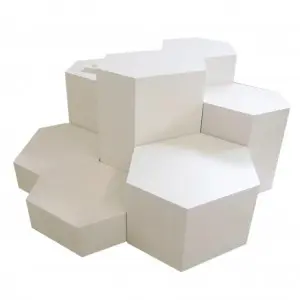Nov . 25, 2024 00:42 Back to list
Enhancing Retail Spaces through Creative Visual Merchandising Techniques
The Art and Science of Visual Merchandising Furnishing
In the ever-evolving world of retail, visual merchandising has emerged as a powerful tool that not only enhances the shopping experience but also drives sales. At the intersection of creativity and strategy, visual merchandising furnishing plays a crucial role in shaping how consumers perceive a brand and its products. This article delves into the principles of visual merchandising furnishing and how it can effectively captivate customers’ attention, creating memorable shopping experiences.
Visual merchandising is a multi-faceted practice that involves the arrangement of products, decor, lighting, and space to create an inviting shopping environment. When we talk about 'furnishing' in this context, we're referring to the physical elements that complement the merchandise, enhancing its appeal and encouraging consumer interaction. From the layout of furniture displays to the selection of colors and textures, every detail counts in crafting an inviting atmosphere.
The Importance of Layout
The layout of a retail space is the foundation upon which effective visual merchandising is built. An intuitive flow allows customers to navigate the store easily, discovering products naturally as they move through the space. In well-furnished environments, pathways lead customers to featured products while encouraging exploration. For instance, using furniture such as display tables or shelves can create focal points throughout the store, drawing attention to specific items and promotions.
Moreover, the arrangement of furniture must accommodate both aesthetic appeal and functionality. For retailers selling clothing, for example, providing changing areas with comfortable seating encourages customers to linger and try on more items, potentially increasing sales. The layout should cater to the target demographic; a high-end boutique might opt for sleek and minimalistic furnishings, while a family-oriented store may choose cozy and inviting setups.
Color and Textures
Color psychology plays a significant role in visual merchandising. Different colors evoke specific emotions and can influence purchasing behavior. A carefully selected color palette can create ambiance and set the mood in the retail space. For example, warm colors like reds and oranges can incite feelings of excitement and urgency, while cooler colors like blues and greens evoke calmness and trust.
In conjunction with color, textures offer another layer of sensory engagement. Utilizing a variety of materials—from soft fabrics to sleek metals—enhances the tactile experience for customers. For instance, plush seating areas can invite customers to relax and browse longer, while metallic finishes may suggest modernity and innovation.
visual merchandising furnishing

Lighting as a Tool
Lighting can dramatically influence the perception of products and the overall atmosphere of a retail space. Properly designed lighting accentuates merchandise, highlights textures, and creates focal points that draw the eye. Bright, focused lighting can be used to illuminate a specific display, making it stand out, while softer ambient lighting can create a welcoming environment.
Incorporating adjustable lighting options allows for flexibility in presentation. Seasonal changes or special promotions can be highlighted through lighting adjustments, keeping the merchandising fresh and engaging. Furthermore, natural lighting is an asset that retailers can leverage, as it creates an inviting and energizing environment that many customers appreciate.
Creating an Emotional Connection
Visual merchandising isn’t just about aesthetics; it’s about storytelling and creating emotional connections. By curating displays that resonate with the target market’s lifestyle, retailers can enhance brand identity and foster loyalty. For example, a furniture store can create a living room setup that feels warm and homely, allowing customers to envision the products in their own spaces.
Storytelling through visuals can also be achieved by theming sections of a store. Seasonal displays can entice customers with timely promotions, while lifestyle-oriented sections may encourage customers to buy complementary items. This approach not only drives sales but also provides a holistic shopping experience that keeps customers coming back.
Conclusion
In conclusion, visual merchandising furnishing is a vital element of the retail landscape that goes beyond simply showcasing products. It encompasses thoughtful design, strategic layout, and sensory engagement to create an inviting atmosphere that resonates with customers. As competition in the retail industry intensifies, mastering the art of visual merchandising is essential for brands aiming to leave a lasting impression and cultivate customer loyalty. By understanding and implementing these principles, retailers can elevate their in-store experiences and drive their success in an increasingly visual world.
-
The Impact of Display Racks on Promoting Sustainable Product Consumption
NewsMay.14,2025
-
The Display Table Is A Catalyst For Sustainable Consumer Engagement
NewsMay.14,2025
-
Sustainable Modern Retail Store Fixtures
NewsMay.14,2025
-
Store Design Innovations for Enhanced Customer Experience and Sales
NewsMay.14,2025
-
How Shoe Shop Displays Influence Sustainable Footwear Choices
NewsMay.14,2025
-
How Display Counter Aids in Efficient Resource Management in Communities
NewsMay.14,2025


















































































































